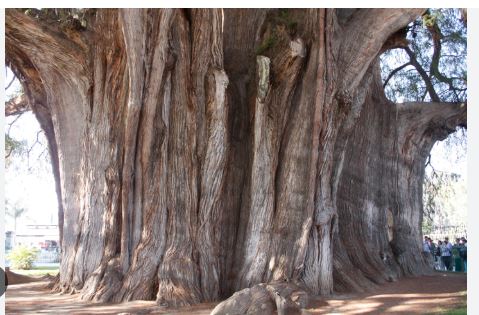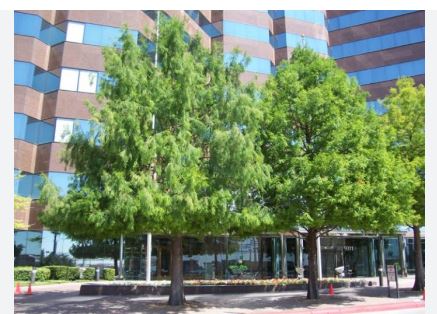
Botanical Classification
The Montezuma Cypress, scientifically known as Taxodium mucronatum, is a member of the Cupressaceae family, which includes cypresses, junipers, and redwoods. It belongs to the genus Taxodium, alongside its close relative, the bald cypress (Taxodium distichum). Commonly referred to as the Mexican cypress, sabino, or ahuehuete (from the Nahuatl word meaning “old man of the water”), Taxodium mucronatum is a coniferous tree that is typically evergreen in warmer climates but may be semi-deciduous in cooler or drier conditions. Its classification within the order Pinales reflects its evolutionary lineage among ancient conifers, with fossil records indicating the genus Taxodium dates back to the Mesozoic era.
History
The Montezuma Cypress holds profound cultural and historical significance, particularly in Mexico, where it is the national tree. Revered by pre-Columbian civilizations like the Aztecs, it was often planted near water sources and sacred sites, symbolizing strength and longevity. The famous Árbol del Tule in Oaxaca, a Montezuma Cypress estimated to be over 2,000 years old, is one of the largest and oldest trees in the world, underscoring its historical prominence. Spanish colonizers noted its use in construction and for shade in colonial settlements. Ecologically, it has stabilized riparian zones for millennia, adapting to Mexico’s diverse climates. Its resilience and grandeur have cemented its status as a cultural icon and ecological cornerstone.
Identifying Characteristics
Montezuma Cypress is a large, majestic tree, often growing 50–130 feet tall with a trunk diameter up to 10 feet or more in ancient specimens. Its feathery, needle-like leaves are soft, light green, and arranged spirally, turning bronze before shedding in drier or cooler conditions. The bark is fibrous, reddish-brown to gray, and deeply furrowed, providing a rugged texture. Unlike bald cypress, it rarely forms prominent “knees” (pneumatophores) unless in consistently flooded soils. Its small, round cones (0.5–1 inch) are green when young, maturing to brown and woody. The tree’s broad, spreading crown and buttressed trunk base give it a distinctive, statuesque appearance.
Distribution and Ecology
Taxodium mucronatum is native to Mexico, Guatemala, and parts of southern Texas, thriving in subtropical and temperate climates. It is found along riverbanks, floodplains, and wetlands from sea level to 7,500 feet elevation, particularly in central and southern Mexico. The tree prefers moist, well-drained soils but tolerates periodic flooding, making it a key species in riparian ecosystems. It supports biodiversity by providing habitat for birds, amphibians, and aquatic species, while its roots stabilize soil against erosion. Montezuma Cypress often grows in association with willows, cottonwoods, and other wetland species, contributing to the health of Mexico’s waterways and floodplains.
Uses
Montezuma Cypress has a wide range of practical, cultural, and ecological uses. Its durable, water-resistant wood is used for construction, furniture, and carvings, though harvesting is limited due to conservation concerns. Historically, Indigenous peoples used its resin for medicinal purposes and its wood for tools and canoes. In landscaping, it is planted for ornamental purposes, valued for its stately form and shade in parks, plazas, and large gardens. Ecologically, it plays a vital role in stabilizing riverbanks, preventing soil erosion, and improving water quality in wetlands. The tree’s cultural significance also makes it a focal point in heritage sites, such as the Árbol del Tule, attracting tourism and fostering environmental awareness.
USDA Zones
Montezuma Cypress is hardy in USDA Zones 8–11, thriving in warm, subtropical to temperate climates. It tolerates temperatures as low as 10–20°F but is sensitive to prolonged freezing, limiting its range in colder regions. Zone 8 includes parts of southern Texas and coastal areas, while Zones 9–11 cover much of Mexico and Central America, where the tree flourishes without frost stress. It requires ample moisture and is best suited for areas with high humidity or access to water sources, such as riverbanks or irrigated landscapes. In colder zones, it may be grown in protected microclimates or as a container plant, though its large size makes this challenging.

Cultivation of Montezuma Cypress (Taxodium mucronatum)
- Site Selection: Choose a site with full sun to partial shade, as Montezuma Cypress thrives in bright conditions but tolerates some shade. It prefers locations near water sources, such as riverbanks, ponds, or low-lying areas, to mimic its natural riparian habitat.
- Soil Requirements: Plant in moist, well-drained soils with a pH of 5.5–7.5. The tree adapts to a range of soil types, including loamy, sandy, or clay soils, and tolerates periodic flooding, but avoid consistently dry or nutrient-deficient sites without irrigation.
- USDA Hardiness Zones: Cultivate in USDA Zones 8–11, where the tree is hardy. It withstands brief cold snaps down to 10–20°F but is not suited for areas with prolonged freezing temperatures. Zones 9–11, covering much of Mexico and southern Texas, are ideal.
- Watering Needs: Ensure consistent soil moisture, especially during the first few years. Montezuma Cypress is highly tolerant of wet conditions, including standing water, but young trees require regular watering in drier climates to establish deep roots.
- Planting Time: Plant in spring or early fall to allow root establishment before extreme heat or cold. Container-grown or balled-and-burlapped trees are preferred for transplanting, with spring planting optimal in cooler parts of its range (Zone 8).
- Spacing: Space trees 20–40 feet apart to accommodate their broad, spreading crowns and large mature size (up to 130 feet tall). For ornamental group plantings, closer spacing (15–20 feet) can create a grove effect, but ensure adequate room for root expansion.
- Propagation: Propagate via seeds or cuttings. Seeds require no stratification but should be sown fresh in a moist, well-drained medium after soaking for 24 hours. Semi-hardwood cuttings, taken in late summer, root with moderate success under mist propagation.
- Fertilization: Apply a balanced, slow-release fertilizer (e.g., 10-10-10) in spring during the first 2–3 years to encourage growth. Mature trees rarely need fertilization, as they are adapted to nutrient-variable riparian soils. Avoid over-fertilizing to prevent weak growth.
- Pruning: Prune minimally to maintain a natural, open form. Remove dead, damaged, or crossing branches in late winter or early spring. Heavy pruning is unnecessary and may disrupt the tree’s stately structure, especially in ornamental settings.
- Pest and Disease Management: Monitor for pests like bagworms or cypress beetles, which may defoliate branches. Use targeted insecticides for severe infestations. Fungal diseases, such as root rot, are rare but can be prevented by ensuring proper drainage and avoiding waterlogged soils.
- Mulching: Apply 2–4 inches of organic mulch (e.g., bark or wood chips) around the base to retain moisture, regulate soil temperature, and reduce weed competition. Keep mulch 2–3 inches from the trunk to prevent rot, especially in wet conditions.
- Winter Care: In Zone 8, protect young trees from frost by wrapping trunks with burlap or using frost blankets during cold snaps. Mature trees are frost-tolerant within their range but may experience leaf drop in cooler or drier conditions, which is normal.
- Landscape Use: Use Montezuma Cypress as a specimen tree in large landscapes, parks, or near water features for its ornamental value and shade. It excels in riparian restoration projects, stabilizing banks and enhancing wetland aesthetics, but its size makes it unsuitable for small urban lots.